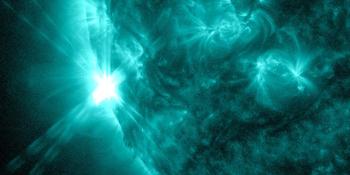Tarkastellaan keskiviikkona, 18. kesäkuuta 2003 arkistoa
Auringon aktiivisuusraportti
Kaikkiin tässä raportissa mainittuihin auringonpurkauksiin on sovellettu Space Weather Prediction Center:n (SWPC) skaalauskerrointa. SWPC:n skaalauskertoimen vuoksi flarepurkaukset ilmoitetaan 42 prosenttia pienempinä kuin tieteellisissä laatutiedoissa. Skaalauskerroin on poistettu arkistoidusta auringonpurkaustiedostamme, jotta se vastaisi todellisia fyysisiä yksiköitä.
Raportti geofysikaalisesta aktiivisuudesta 2003 Jun 18 2200 UTCValmisteli NOAA © SWPC ja käsitteli SpaceWeatherLive.com
USAF:n ja NOAA:n yhteinen raportti Auringon ja geofysikaalisesta aktiivisuudesta
SDF-luku 169 julkaistu 2200Z kello 18 Jun 2003IA. Auringon aktiivisten alueiden ja aktiivisuuden analyysi välillä 17-2100Z – 18-2100Z Solar activity increased to high levels today. Region
386 (S07E43) produced an M6.8 x-ray flare (correlated using SXI
imagery) at 17/2255Z that had an associated Tenflare (2100 sfu),
Type IV and Type II radio sweeps (an estimated shock velocity of 1000
km/sec). This region showed growth in the magnetic structure
surrounding the dominant lead spot as a delta complex has become
evident since yesterday. The penumbral field coverage has changed
little over the period. Newly numbered Region 387 (N18E62) produced
several minor flares during the interval.
IB. Auringon aktiivisuusennuste
Solar activity is expected to be at
moderate to high levels. Region 386 has the potential to produce an
isolated major flare.
IIA. Geofysikaalisen aktiivisuuden yhteenveto 17-2100Z – 18-2100Z
The geomagnetic field was at predominantly minor to major storm
levels with an isolated period of severe storm conditions seen at
high latitudes between 18/0600 and 0900Z. A co-rotating integrated
region preceding a recurrent high speed coronal hole stream and is
believed to responsible for the storm conditions. The greater than
10 Mev proton flux at geosynchronous orbit reached event threshold
at 18/2050Z and due to the recent activity the exact source for this
particle event is not certain.
IIB. Geofysikaalisen aktiivisuuden ennuste
The geomagnetic field is
expected to be at predominantly active to minor storm levels due to
a recurrent high speed coronal hole stream. Isolated major storm
conditions are possible on day one due to the potential for
transient activity. The greater than 10 MeV proton event should
remain above threshold level through the first day of the interval.
III. Tapahtuman todennäköisyydet 19 Jun – 21 Jun
| Luokka M | 60% | 60% | 60% |
| Luokka X | 20% | 20% | 20% |
| Protonit | 99% | 50% | 25% |
| PCAF | in progress | ||
IV. Penticton 10,7 cm vuo
Havaittu 18 Jun 120 Ennusteet 19 Jun-21 Jun 120/120/120 90 vuorokauden keskiarvo 18 Jun 125
V. Geomagneettinen A-indeksit
Havaittu Afr/Ap 17 Jun 030/050 Arvioitu Afr/Ap 18 Jun 035/050 Ennusteet Afr/Ap 19 Jun-21 Jun 025/035-020/025-020/025
VI. Geomagneettisen toiminnan todennäköisyydet 19 Jun – 21 Jun
| A. Keskileveysasteet | |||
|---|---|---|---|
| Aktiivinen | 40% | 50% | 50% |
| Heikko myrsky | 30% | 20% | 20% |
| Voimakas myrsky | 15% | 05% | 05% |
| B. Korkeat leveysasteet | |||
|---|---|---|---|
| Aktiivinen | 40% | 50% | 50% |
| Heikko myrsky | 40% | 30% | 30% |
| Voimakas myrsky | 20% | 10% | 10% |
Kaikki ajat ovat UTC-aikoja
<< Siirry päivittäiselle yleiskatsaussivulle
Uusimmat uutiset
Viimeisimmät foorumiviestit
Unproven theories 1076Geomagnetic Storm June 28 2024 80Why are the largest flares occurring at the limb? 2Noctilucent clouds 20Latest SC25 Predictions 145
Lisää aiheitaTue SpaceWeatherLive.com -sivustoa!
Monet ihmiset seuraavat SpaceWeatherLive -sivuilta Auringon toimintaa tai onko revontulia, mutta kun on enemmän liikennettä sitä suuremmat ovat palvelimen kustannukset. Harkitse lahjoitusta, jos pidät SpaceWeatherLivestä, jotta voimme pitää edelleen verkkosivustomme saatavilla!

Avaruussäätiedot
| Viimeisin X-flare | 10/06/2024 | X1.55 |
| Viimeisin M-flare | 25/06/2024 | M1.0 |
| Viimeisin geomagneettinenmyrsky | 28/06/2024 | Kp8- (G4) |
| Pilkuttomat vuorokaudet | |
|---|---|
| Viimeisin auringonpilkuton vuorokausi | 08/06/2022 |
| Kuukausittainen auringonpilkkuluku | |
|---|---|
| toukokuuta 2024 | 171.7 +35.2 |
| kesäkuuta 2024 | 153.9 -17.8 |
| Viimeiset 30 päivää | 152.9 +8.3 |


